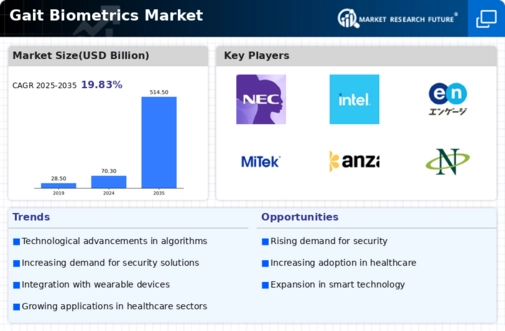Market Growth Projections
The Global Gait Biometrics Market Industry is poised for remarkable growth, with projections indicating a compound annual growth rate (CAGR) of 19.83% from 2025 to 2035. This growth trajectory reflects the increasing recognition of gait biometrics as a reliable identification method across various sectors. The market is expected to expand significantly, reaching 514.5 USD Billion by 2035. Factors contributing to this growth include advancements in technology, rising security concerns, and the integration of gait biometrics into everyday devices. The future landscape of the market appears promising, with opportunities for innovation and expansion.
Growing Adoption in Healthcare
The healthcare sector's increasing adoption of gait biometrics significantly contributes to the Global Gait Biometrics Market Industry. Gait analysis is utilized for monitoring patients' mobility and rehabilitation progress, providing valuable insights into their physical health. Hospitals and rehabilitation centers are increasingly integrating gait biometrics into their patient care protocols, allowing for personalized treatment plans. This trend is likely to accelerate as healthcare providers recognize the benefits of objective data in improving patient outcomes. The market's growth in this sector aligns with the broader trend of digitization in healthcare, indicating a robust future for gait biometrics.
Integration with Smart Devices
The integration of gait biometrics with smart devices is a notable driver of the Global Gait Biometrics Market Industry. As wearable technology becomes more prevalent, the potential for gait recognition systems to be embedded in smartphones and fitness trackers expands. This integration allows for seamless user experiences, enabling individuals to monitor their health and security through familiar devices. The convenience and accessibility of gait biometrics may lead to increased consumer acceptance and usage. As the market evolves, the synergy between gait biometrics and smart devices is expected to foster significant growth opportunities.
Rising Demand for Security Solutions
The increasing need for advanced security solutions drives the Global Gait Biometrics Market Industry. As organizations and governments seek to enhance security measures, gait biometrics offers a unique advantage by enabling identification based on walking patterns. This technology is particularly appealing in high-security environments, such as airports and government buildings, where traditional methods may fall short. The market is projected to reach 70.3 USD Billion in 2024, reflecting a growing recognition of the importance of biometric solutions in safeguarding assets and individuals. The integration of gait biometrics into security systems is likely to become more prevalent as threats evolve.
Regulatory Support and Standardization
Regulatory support and the push for standardization in biometric technologies bolster the Global Gait Biometrics Market Industry. Governments worldwide are recognizing the need for secure identification methods, leading to the establishment of guidelines and frameworks that promote the adoption of biometric systems. This regulatory environment encourages investment and innovation within the gait biometrics sector. As standards are developed, the market is likely to experience accelerated growth, with stakeholders benefiting from increased consumer trust and acceptance. The alignment of regulatory efforts with technological advancements suggests a favorable landscape for the future of gait biometrics.
Technological Advancements in Biometric Systems
Technological innovations play a pivotal role in the expansion of the Global Gait Biometrics Market Industry. Advances in machine learning and artificial intelligence enhance the accuracy and efficiency of gait recognition systems. These improvements enable real-time analysis and identification, making gait biometrics a viable option for various applications, including law enforcement and healthcare. As the technology matures, it is expected that the market will experience substantial growth, with projections indicating a rise to 514.5 USD Billion by 2035. The continuous evolution of biometric technologies suggests a promising future for gait recognition systems.












